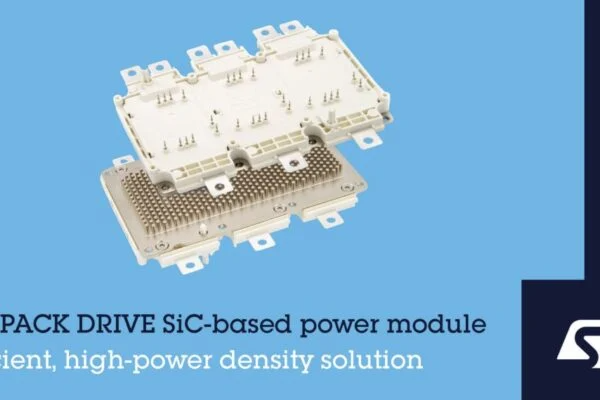STMicroelectronics has unveiled new high-performance power modules designed specifically for electric vehicles to deliver increased performance and range. Hyundai is already using the silicon carbide (SiC)-based power modules in its E-GMP electric vehicle platform.
With a total of five new SiC MOSFET-based power modules, ST’s new Acepack Drive series offers vehicle manufacturers flexible options, as not only are there different power ratings to choose from, but the operating voltages commonly used in electric vehicle (EV) traction systems are also supported. The power modules are offered in the Acepack Drive package optimized for traction applications. Thanks to sintering technology, they feature high reliability, are robust and can be integrated by manufacturers into EV drives. The main power semiconductors incorporated are ST’s third-generation (Gen3) STPower SiC MOSFETs, which combine an industry-leading figure of merit (product of RDS(on) and die area) with very low switching energy and outstanding performance in synchronous rectifier applications.
“ST’s silicon carbide solutions are enabling leading automotive manufacturers to set the pace for electrification with the development of future generations of EVs,” praised Marco Monti, president of STMicroelectronics’ Automotive and Discrete Group. “Our third-generation SiC technology vouches for the highest levels of power density and energy efficiency, helping electric vehicles achieve not only superior performance and range, but also short charging times.”
Higher efficiency for traction inverters
Hyundai Motor Company has decided to use the Acepack Drive SiC-MOSFET Gen3-based power modules in its current-generation EV platform, designated E-GMP. Here, the modules will be used in particular in the KIA EV6. They will be used in the traction inverters, a key position for range and efficiency of electric drives.
ST has already supplied STPower SiC components for more than three million high-volume passenger cars worldwide. Compared to conventional silicon power semiconductors, SiC devices can handle higher operating voltages, enabling shorter charging times and providing superior vehicle dynamics. And all this despite smaller dimensions. Energy efficiency is also improved, which increases the operating range, and last but not least, reliability can also be increased. SiC technology is achieving mass adoption in various EV systems such as DC/DC converters, traction inverters and on-board chargers (OBCs), with bidirectional operation providing the ability to feed back from the vehicle battery to the grid. The SiC strategy pursued by ST as an integrated device manufacturer is intended to guarantee quality and security of supply so that the electrification strategies of car manufacturers can be accommodated. This strategy seems to be meeting with approval: Just recently, the company announced the establishment of a fully integrated SiC substrate manufacturing facility in Catania (Italy), which is expected to start production in 2023.
ST’s ADP280120W3, ADP360120W3 and ADP480120W3(-L) 1,200-V modules have already entered volume production, while mass production of the Acepack Drive ADP46075W3 and ADP61075W3 750-V modules is scheduled to begin by March 2023. The modules offer a plug-and-play solution for traction inverters that is suitable for direct liquid cooling and features a pin-fin array in the interest of efficient heat dissipation. Specified for a maximum junction temperature of 175°C, the modules feature durable and reliable press-fit connections and chips sintered to the substrate to provide longer life in automotive applications. ST will further expand the product portfolio with Acepack Drive versions based on IGBTs and diodes.
The modules are based on a substrate technology known as AMB (Active Metal Brazed), which is known for excellent thermal efficiency and high mechanical strength. A separate NTC resistor is mounted for each substrate. The modules are also available for either weld or screw mounting to the busbar, providing flexibility for different mounting requirements. An additional plus in flexibility comes from the long busbar option, which makes it possible to monitor the motor current using a Hall-effect sensor.



Leave a comment